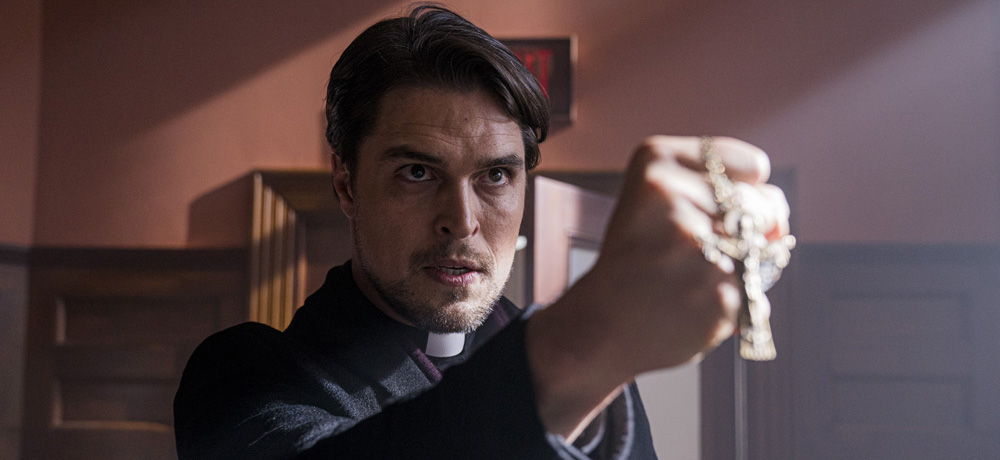


“Beware of false prophets, which come to you in sheep’s clothing but inwardly they are ravening wolves.” This Biblical phrase that closes writer-director Evan Spiliotopoulos’s The Unholy perfectly encapsulates it. A film about how nothing is what it seems in the context of a demonic horror film rooted in Catholicism. The church, a symbol of good, is used as the backdrop, but as in other films like The Nun, what takes place among the pews is wholly evil. And in a sense, by speaking of false prophets and introducing an untrustworthy journalist character, the film speaks of the effects of “fake news” and the consequences that ensue when false narratives are intentionally planted. It’s smart in that respect, but just because a film has a James Wan story credit, or in this case, a Sam Raimi producing credit, it sadly doesn’t spell a good supernatural tale. While many like The Nun try too hard to be scary, The Unholy does the opposite.
Based on James Herbert’s best-selling book Shrine, the film follows disgraced journalist Gerry Fenn (Jeffrey Dean Morgan) as he’s sent on assignment to a small Massachusetts town. The gig? Investigate the strange claims that cows are being mysteriously mutilated. When that turns out to be a hoax, he does what he does best: fabricate a story. (He’s disgraced for a reason.) Because of Morgan’s charm and charisma as the character, this is a film that starts with a light, comedic tone. But he also carries weariness, a relatable trait for anyone who’s about to experience horrors. When Fenn is drawn to a petrified oak on the neighboring church property, he finds a Kern Baby buried beneath its trunk. The legend goes that farmers would bury them in their fields for good luck, but they could also be a vessel to hold the spirit of evil. Fenn decides to break it, blaming his fake cattle mutilation story on a curse unleashed. But unbeknownst to him, his self-serving actions open Pandora’s Box, marking the beginning of the unholy events to come.
Soon after, Fenn comes across a mysterious girl kneeling in front of the same tree, praying or speaking to something unseen. Her name is Alice (Cricket Brown in her breakout role), the niece of the church priest, Father Hagan (William Sadler). This event perhaps wouldn’t have seemed that strange if Alice didn’t suffer from congenital cholesteatoma, a condition that has left her unable to hear or speak since birth. As Fenn recounts what he saw, everyone is understandably in disbelief. But then, she speaks for everyone to hear and her deafness is seemingly cured—she states that she’s been touched by the Virgin Mary and is speaking through her. Fenn, a journalist known for faking stories, finally has his scoop and it’s something truly unbelievable. As parishioners gather to be cured by Alice, a media firestorm follows, drawing attention to all the “miracles” happening in this small farming community. But there’s a darkness that’s manifesting unnoticed. And as Father Hagan, Fenn, and others become suspicious that this isn’t Mary, but the work of Satan, and as the secrets of the town’s church and history are revealed, Alice risks leading this community down a road of tragedy.
Much like Morgan, Brown is one of the film’s highlights as she impresses in her first feature film role. Any first big role is daunting, but it must be so in a horror film where you basically carry the source of the horror on your shoulders. She has a lot of dramatic moments to chew on. There are also a lot of great contrasts here, from the simplistic production design and quaint, idyllic setting that’s home to something sinister, and the character design of “Mary,” whose robes mimic but also look decayed in comparison to the holy figure. I love movies about nuns and the church because there are so many intriguing and dark aspects to it that reflect what’s really hidden behind the sanctity of the institution, but The Unholy feels empty. It’s not scary for one—a sin needing of a confessionary—and even the film’s “villain” isn’t very frightening apart from some talon-like hands. The final showdown, too, leaves much to be desired. And its characters are pretty one-note; interesting to an extent, but we don’t learn anything beyond the obvious.
There’s a lot of fine blood and fire imagery in an attempt to get both a reaction from the audience as well as the characters, and it shows that Spiliotopoulos has more flair as a director than as a writer. It’s all style, no substance.
Movie Score: 2/5